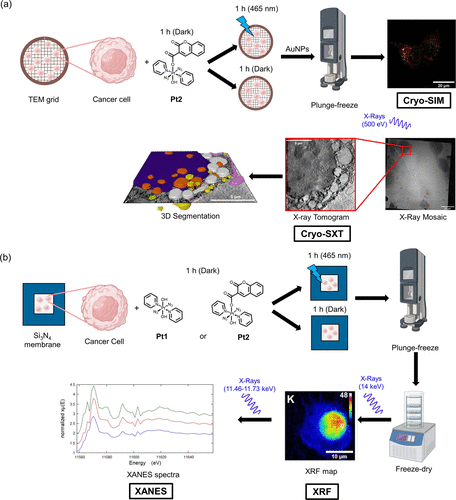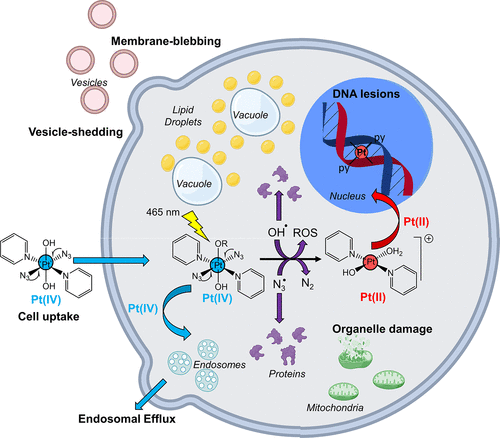Platinum is widely used in cancer treatments, such as the chemotherapy drug Cisplatin. However, platinum is indiscriminately toxic and therefore causes harmful side effects. Cancer cells can also develop a tolerance for the drug, rendering treatment less effective. One potential solution to this problem is to develop therapeutic compounds that are non-toxic until they are activated. Photodynamic therapy (PDT) uses light to activate otherwise inert molecules. For several decades, doctors have been using PDT to target accessible cancers, such as skin, head and neck, prostate, and bladder cancer. However, PDT agents rely on the presence of oxygen during activation. Photoactivated chemotherapy (PACT) is a different type of light-activated therapy. It uses light to alter the chemical structure of a prodrug, releasing active agents directly into cells. In work recently published in the Journal of the American Chemical Society, researchers from the University of Warwick worked with Diamond staff to investigate the in-cell behaviour of platinum-based prodrugs. Using a combination of synchrotron techniques, they were able to visualise, for the first time, how cells change when they uptake such platinum compounds and once those are photoactivated, and how this process influences the chemical composition of cells. Their results highlight how synchrotron techniques can provide new insights into the action of photoactivated platinum prodrugs inside cancer cells.

This research investigated two promising agents for photoactivated chemotherapy - Pt1 (trans, trans, trans-[Pt(pyridine)2(N3)2(OH)2] and its coumarin derivative Pt2 (trans, trans, trans-[Pt(pyridine)2(N3)2(OH)(coumarin-3-carboxylate)). In the absence of light, these two complexes are inert. When irradiated with visible light, however, they release active platinum compounds that are toxic to cancer cells.
Having demonstrated the anticancer effects of these compounds in vitro, the research team wanted to investigate how they behaved in cells. They grew cancer cells on grid surfaces suitable for synchrotron imaging, and then added photoactivatable compounds to these same cells in a darkened room. One set of grids was then left in the dark, with the other illuminated using an LED lamp.
For analysis of the cellular ultrastructure post exposure at beamline B24, cells were plunge frozen in liquid ethane to preserve their physiological state and analysed at low temperatures. Following 3D imaging at B24, cell-bearing grids were treated and freeze dried to allow elemental analyses at room temperature for experiments at beamline I14.
The team used a combination of synchrotron imaging techniques at Diamond – cryo-SIM (Structured Illumination Microscopy), Cryo-SXT (Soft X-ray Tomography), XRF (X-ray Fluorescence) and XANES (X-ray Absorption Near Edge Structure) – to investigate photo-activated materials and understand their mode of action and physiological relevance.
Dr Cinzia Imberti at the University of Warwick explains:
This combination of techniques offered us complementary information. Cryo-SIM shows you organelles - what's in the cell, and where. So it gives you a map of the cells. Cryo-SXT shows you the effect of the complex on cell morphology and the organelles. XRF focuses on specific elements, and we used it to see the distribution of platinum across the cells. And we used XANES to investigate the oxidation state of the platinum.

Cryo-SXT results showed a dramatic difference between treated and untreated cells. Treated cells displayed distorted ultrastructural features with skewed vesicle distribution and an abundance of vacuoles - essentially empty spaces – a presentation that will require further work to understand how and why they formed.
Using XRF, the team saw higher levels of platinum in cells that had been treated and irradiated. This suggests that the drug could be damaging the cell membrane, allowing increased penetration. Alternatively, it could be interfering with the processes that normally remove platinum from the cell.
The XANES results showed that platinum compounds undergo a photoreduction process during irradiation, with the Pt(IV) reducing to Pt(II). They confirm that this also happens in cells, but that not all of the platinum is reduced. There are several possible reasons why this may be the case. Within the complex environment of the cell, these compounds may not be reduced productively or could be undergoing a range of reactions such as reoxidation. However, even without complete reduction, the compound is still very toxic as confirmed with cryo-SXT.
Dr Imberti said:
The first author on the paper, Elizabeth Bolitho, did her PhD at Beamline I14 at Diamond and Warwick University, and we were lucky to have her synchrotron expertise on the team for this work. We also received invaluable support from the staff on both beamlines. Our results show that these synchrotron techniques are a valuable new avenue of research for investigating metal-based drugs in cells.
The team are continuing to work on new derivative compounds. The current compounds are activated by blue light, which doesn't penetrate very far into living tissue. They're hoping to tune the compounds to be activated by longer wavelengths, which are more penetrating.
To find out more about the B24 beamline or discuss potential applications, please contact Principal Beamline Scientist Maria Harkiolaki: maria.harkiolaki@diamond.ac.uk. For details on the work on I14 contact Imaging Group Leader Paul Quinn: paul.quinn@diamond.ac.uk.
Bolitho E et al. Single-Cell Chemistry of Photoactivatable Platinum Anticancer Complexes. Journal of the American Chemical Society (2021). DOI:10.1021/jacs.1c08630.
Diamond Light Source is the UK's national synchrotron science facility, located at the Harwell Science and Innovation Campus in Oxfordshire.
Copyright © 2022 Diamond Light Source
Diamond Light Source Ltd
Diamond House
Harwell Science & Innovation Campus
Didcot
Oxfordshire
OX11 0DE
Diamond Light Source® and the Diamond logo are registered trademarks of Diamond Light Source Ltd
Registered in England and Wales at Diamond House, Harwell Science and Innovation Campus, Didcot, Oxfordshire, OX11 0DE, United Kingdom. Company number: 4375679. VAT number: 287 461 957. Economic Operators Registration and Identification (EORI) number: GB287461957003.